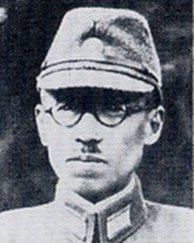Allegiance Japan Years of service 1908 – 1945 Rank General officer | Name Sadamu Shimomura Education Army War College | |
 | ||
Born September 23, 1887Kochi Prefecture, Japan ( 1887-09-23 ) Commands held Thirteenth ArmyNorthern China Area Army Battles/wars Second Sino-Japanese WarWorld War II Died March 25, 1968, Bunkyo, Tokyo City, Tokyo, Japan Battles and wars | ||
Other work Ministry of War of Japan | ||
Sadamu Shimomura (下村 定, Shimomura Sadamu, 23 September 1887 – 25 March 1968) was a general in the Imperial Japanese Army and the final Minister of War of the Empire of Japan.
Biography
Shimomura was a native of Kōchi Prefecture, and a graduate of the 20th class of the Imperial Japanese Army Academy in 1908. His classmates included Prince Asaka, Prince Higashikuni Naruhiko, Prince Kitashirakawa Naruhisa, Mitsuru Ushijima, Heitarō Kimura, Takashi Sakai, and Shōjirō Iida. He subsequently graduated from the 28th class of the Army Staff College in 1916. After serving in a number of staff and administrative positions within the Imperial Japanese Army General Staff, Shimomura was posted to France as a military attaché in 1919. He returned to the Strategy and Planning bureau of the General Staff in 1921. He participated as part of the Japanese delegation to the Geneva Naval Conference negotiations from 1928–1929 and in 1931. From 1933-1935 he was commander of the IJA 1st Heavy Field Artillery Regiment.
In 1935, Shimomura was assigned to the staff of the Kwantung Army and promoted to major general in 1936. He returned to the General Staff as Chief of the 4th Bureau from 1936–1937, and of the 1st Bureau from 1937-1938. He was strong proponent of a more aggressive approach towards the Kuomingtang government in the Shanghai area and his recommendations influenced the decision of the Japanese General Staff to authorize the landings of the Japanese Tenth Army at the start of the Battle of Shanghai.
Shimomura was promoted to lieutenant general in 1939. He was Commandant of the Artillery School in 1940, and given a field command in 1942 in the form of the Japanese Thirteenth Army based in Shanghai and surrounding provinces primarily as a garrison force to deter the possible landings of the Allies of World War II in the lower Yangtze River area of east central China.
In March 1944, Shimomura was withdrawn to the Japanese home islands and became commander of the Western District Army, another force intended to defend against Allied landings. However, in November 1944, he returned to China as commander of the North China Area Army.
In 1945, Shimomura was promoted to full general, and on 23 August (after the surrender of Japan), was appointed final Army Minister under the Higashikuni cabinet. One of the reasons for his selection was that he had never been involved in hostilities against the United States at any point in his military career. Shimomura was also concurrently the final Inspector-General for Military Training. His primary task was to oversee the demobilization of the Imperial Japanese Army.
As with all other members of the former Japanese government, Shimomura was briefly taken into custody by the American occupation authorities from 1946–1947, but was released without trial.
In June 1959, he was elected to the House of Councilors in the post-war Diet of Japan for a single term with the support of the Liberal-Democratic Party. Shimomura died in a traffic accident on 25 March 1968.
